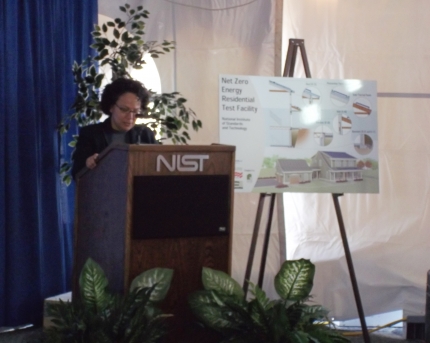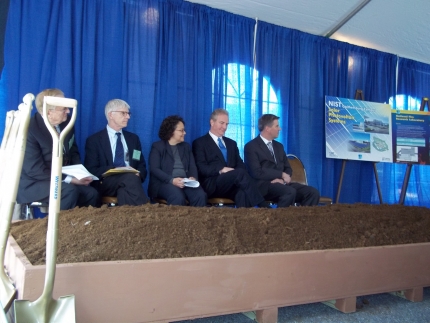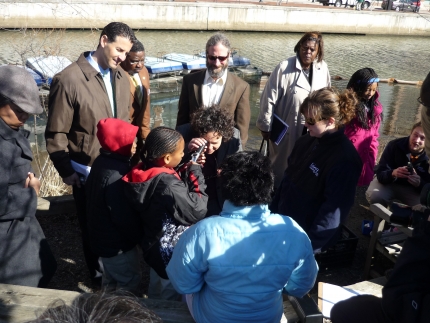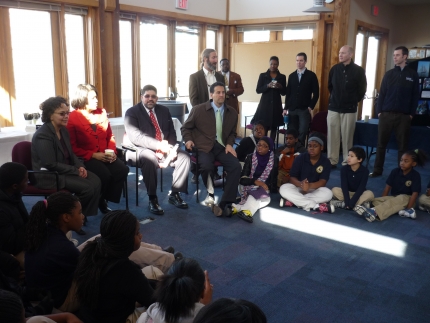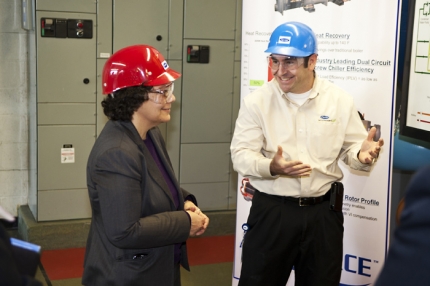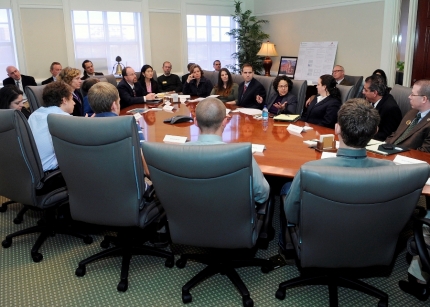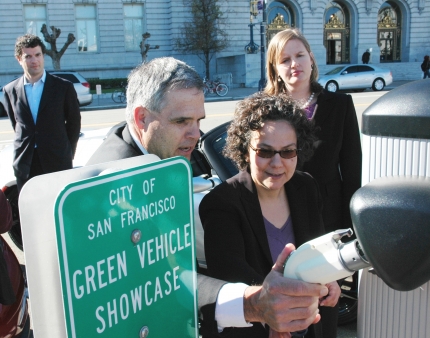Council on Environmental Quality Blog
Winning the Future in our Research Laboratories and Facilities
Posted by on April 4, 2011 at 2:45 PM EDTWhen President Obama called for 80% of our energy to come from clean sources by 2035, he challenged Americans to awaken their creativity, innovation and expertise to help us meet this charge. Across the country, public and private institutions are leading the way in developing the research and technologies that will help us win the future.
Right here in Gaithersburg, MD, the National Institute of Standards and Technology (NIST) is doing pioneering work to boast state of the art greener, safer buildings and homes. I was pleased to take part in the ground breaking for three exciting new facilities on the NIST campus.
On the outside, the NIST Net-Zero Energy Residential Test Facility will resemble a typical suburban home occupied by a Washington area family, but no one will actually live there (NIST would probably get plenty of volunteers to live there in a moment!). Researchers will simulate the daily energy usage of a family of four and prove that the typical American home can still use very little energy and produce as much as it consumes. With the installation of state-of the art energy saving windows, solar thermal panels, and energy efficient appliances, the net-zero test facility will bring us closer to the next generation of homes that can produce as much energy from renewable resources as it consumes over the course of a year. It will also help create clean energy jobs and the industries of the future.
NIST's 2,000 new solar energy panels will catch the sun's rays and with the flip of a switch, feed up to 600kW of electricity directly into the electrical grid. This renewable energy produced by the sun will fuel the groundbreaking work happening on the NIST campus, and exemplifies our commitment to innovative and responsible government. Instead of wasting energy and emitting carbon pollution, the NIST facility in Gaithersburg is acting as a good neighbor to local families and communities by protecting public health and producing energy with greenhouse gas emission-free energy.
The third new facility, the National Structural Fire Resistance Laboratory, will give researchers a place to develop the solutions and technologies that will ensure we have the safest buildings in the world. Stemming from the tragic collapse of the World Trade Center, NIST scientists are working to ensure that our buildings can withstand severe fire conditions. The Laboratory will provide a unique capability for testing full-scale structural elements and systems under realistic fire conditions to protect our homes and buildings from disaster. The facility will also serve as a reminder of how our nation responds in the face of hardship: that we are a country that remembers the tragedies from our past, and always strives to build a safer future.
Turning the soil and breaking ground on these three important projects at NIST shows once again that we are on the cusp of delivering a new energy future for America. In research labs across the country, the future is being won each day. It is in these centers where landmark discoveries are made and where we see American innovation at its finest. I want to thank Representative Van Hollen and Representative Edwards for supporting the American Recovery and Reinvestment Act, which invests in facilities like the ones at NIST. We are already leading the way to becoming clean energy leaders, and I look forward to continuing our work to build a healthy and prosperous future for America.
Nancy Sutley is Chair of the White House Council on Environmental Quality
Learn more about Energy and EnvironmentGoing Green and Saving Green
Posted by on April 1, 2011 at 7:57 PM EDTEd. Note: Everyday the White House gets a lot of questions via Twitter. Yesterday, @WhiteHouse was asked:
Going green is good, but costly, how is the US going to go ‘green’ energy without raising the deficit?
Check out the response from the White House Council on Environmental Quality and follow us on Twitter for the latest news from the White House and opportunities to engage with us.
When President Obama spoke to Americans in his State of the Union Address, he laid out a plan to take responsibility for our deficit by investing in what makes America stronger, and cutting what doesn’t. And he recognized that to win the future, we must make America the best place on earth to do business and invest in a strong, modern clean energy economy.
As long as our economy relies on oil, we will pay the price – not just in dollars spent on a finite source of energy, but also in dollars lost in a missed opportunity to become the world’s leading provider of clean energy technology. Instead of being satisfied with the energy resources of our past, we must push ourselves to create the next generation of sustainable, affordable energy solutions.
Sustainable practices -- like investing in energy efficient technologies -- save money in the long run. If the U.S. became 20 percent more energy efficient, we would save more than $200 billion each year. Here are a few cost-saving programs already underway:
- The Better Buildings Initiative: The President’s Better Buildings Initiative which includes new and expanded incentives for building efficiency – would improve commercial building efficiency 20% by 2020 and help reduce energy costs for American business by $40 billion.
- HOMESTAR Program of Rebates Delivered Directly to Consumers: The Administration continues to advocate for the consumer-friendly HOMESTAR program. Like the Cash for Clunkers program, consumers would be eligible for direct HOMESTAR rebates at the point of sale for a variety of energy-saving investments in their homes.
- A Framework for Continued Growth: The “Recovery through Retrofit” initiative led by the Council on Environmental Quality and Vice President’s Middle Class Taskforce identified market-based solutions to help the energy efficiency industry overcome long-standing barriers. These policies will improve access to information about home energy use and to affordable financing, and will also help create a skilled and certified retrofit workforce.
The Federal Government is putting these principles into action in its own operations. By meeting just one of the sustainability targets President Obama has set for Federal agencies, the government will avoid up to $11 billion in energy costs by 2020. We are also using the Federal government’s purchasing power to support American ingenuity and build the healthy and prosperous country of tomorrow.
Sahar Wali is Communications Director at the White House Council on Environmental Quality
Learn more about Energy and EnvironmentLearning from you, for you, for our Great Outdoors
Posted by on March 18, 2011 at 4:34 PM EDTIn building the President's America's Great Outdoors initiative, we sought to create a 21st century conservation legacy that reflects the priorities of the American people and preserves our nation's natural treasures for future generations. That's why we went across the country to learn from communities - especially our youth - about the protections and places that they care about the most. By listening to you, we were able to launch a conservation agenda with you, for you. We learned a lot from you and the learning doesn't stop there.
As we visit communities across the country, we have the chance to continue this dialog. On a recent visit to Baltimore, MD, I had the chance to visit students at the Living Classrooms Foundation's East Harbor Campus and hear from them directly about what they're learning from the environment that's all around them even in a dense urban setting. Joined by Congressman John Sarbanes and Baltimore Mayor Stephanie Rawlings-Blake, I got my hands dirty with these fifth through eighth graders working on projects that improve the health of their community while learning about the environment. We hear from students and teachers about how kids are becoming better students and getting more out of school through hands-on interaction with nature and science.
Growing up on Little Neck Bay in New York, I remember not being able to swim in or enjoy the Bay because it was too polluted. Through planting floating wetlands, the kids we met are contributing directly to making the Baltimore Inner Harbor fishable and swimmable by 2020 and making the Chesapeake Bay healthier. These students are getting the change to learn in new ways about the outdoors, in the outdoors while giving back to their community.
When President Obama created the America's Great Outdoors Initiative, he had America's kids especially in mind. Today, kids spend far more time inside than their parents did. Many of them also live in cities or suburbs, where it can be hard to find a safe and accessible green space to play. America's children will live with the consequences of the decisions we make today about whether to protect and restore our outdoor spaces, or lose them to pollution or poorly planned development.
Through the Administration's America’s Great Outdoors Initiative, we are confronting these challenges through a new 21st century conservation and recreation agenda. This agenda will not only benefit our urban centers but America's vast rural communities and economies as well. You too can be a part of America's Great Outdoors.
Nancy Sutley is Chair of the Council on Environmental QualityLearn more about Energy and EnvironmentWinning the Clean Energy Future in Communities Across America
Posted by on March 8, 2011 at 10:59 AM EDTLearn more about Energy and EnvironmentWhat You Missed: Open For Questions on the America's Great Outdoors Initiative
Posted by on March 4, 2011 at 8:20 PM EDTYesterday, White House Council on Environmental Quality Chair Nancy Sutley and U.S. Environmental Protection Agency Administrator Lisa Jackson, hosted a live chat to answer your questions about the America's Great Outdoors initiative. The initiative seeks to reinvigorate our approach to conservation and reconnect Americans, especially young people, with the lands and waters that are used for farming and ranching, hunting and fishing, and for families to spend quality time together. They took questions from YouTube videos and Facebook participants from across the country on ways to develop a conservation and recreation agenda that makes sense for the 21st century.
Check out the full video below or skip to the questions you're interested in by using the links below:
Learn more about Energy and EnvironmentJoin Us in Continuing the Conversation on America’s Great Outdoors
Posted by on February 28, 2011 at 12:09 PM EDTLast week, President Barack Obama announced the Administration’s action plan, under the America's Great Outdoors initiative, to achieve lasting conservation of the outdoor spaces that power our nation’s economy, shape our culture, and build our outdoor traditions. This initiative seeks to reinvigorate our approach to conservation and reconnect Americans, especially young people, with the lands and waters that are used for farming and ranching, hunting and fishing, and for families to spend quality time together. Recognizing that many of these places and resources are under intense pressure, the President established the America’s Great Outdoors Initiative last April to work with the American people in developing a conservation and recreation agenda that makes sense for the 21st century.
This report is the product of 51 listening sessions across the nation—21 specifically with young people—consisting of more than 10,000 participants spanning all ages and backgrounds, plus more than 100,000 comments from citizens across the nation sharing with us your priorities for the lands and waters that you know best. We built this plan with your input and your involvement doesn't stop there.
On March 3, 2011, U.S. Environmental Protection Agency Administrator Lisa Jackson and I will continue the conversation by hosting the first America’s Great Outdoors live chat. You can join by video before the chat or by Facebook during the chat. You can post your YouTube video questions by responding to the video above, or by sending your questions to policyoutreach@ceq.eop.gov. To submit by Facebook during the live chat, sign on to our Facebook chat application on Thursday March 3rd at 4:30 pm (EST).
We look forward to talking to you!
Nancy Sutley is Chair of the Council on Environmental Quality
Learn more about Energy and Environment
- &lsaquo previous
- …
- 26
- 27
- 28
- 29
- 30
- 31
- 32
- 33
- 34
- …
- next &rsaquo
White House Blogs
- The White House Blog
- Middle Class Task Force
- Council of Economic Advisers
- Council on Environmental Quality
- Council on Women and Girls
- Office of Intergovernmental Affairs
- Office of Management and Budget
- Office of Public Engagement
- Office of Science & Tech Policy
- Office of Urban Affairs
- Open Government
- Faith and Neighborhood Partnerships
- Social Innovation and Civic Participation
- US Trade Representative
- Office National Drug Control Policy
categories
- AIDS Policy
- Alaska
- Blueprint for an America Built to Last
- Budget
- Civil Rights
- Defense
- Disabilities
- Economy
- Education
- Energy and Environment
- Equal Pay
- Ethics
- Faith Based
- Fiscal Responsibility
- Foreign Policy
- Grab Bag
- Health Care
- Homeland Security
- Immigration
- Innovation Fellows
- Inside the White House
- Middle Class Security
- Open Government
- Poverty
- Rural
- Seniors and Social Security
- Service
- Social Innovation
- State of the Union
- Taxes
- Technology
- Urban Policy
- Veterans
- Violence Prevention
- White House Internships
- Women
- Working Families
- Additional Issues

